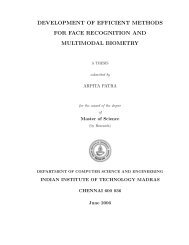The Enigma of Group Theory - Department of Computer Science ...
The Enigma of Group Theory - Department of Computer Science ...
The Enigma of Group Theory - Department of Computer Science ...
Create successful ePaper yourself
Turn your PDF publications into a flip-book with our unique Google optimized e-Paper software.
http://www.cs.bris.ac.uk University <strong>of</strong> Bristol, <strong>Department</strong> <strong>of</strong> <strong>Computer</strong> <strong>Science</strong><br />
Notice that a cycle is not a unique way <strong>of</strong> representing a permutation. As another example we have<br />
�<br />
1<br />
3<br />
2<br />
2<br />
3<br />
1<br />
�<br />
= (1, 3)(2) = (3, 1)(2).<br />
<strong>The</strong> identity permutation is represented by (). Again, as mathematicians are lazy we always write<br />
(1, 3)(2) = (1, 3). This can still lead to ambiguities as (1, 2) could represent a function<br />
{1, 2} → {1, 2} or {1, 2, . . . , n} → {1, 2, . . . , n}.<br />
Which function it represents is usually however clear from the context.<br />
Two cycles (x1, . . . , xn) and (y1, . . . , yn) are called disjoint if {x1, . . . , xn} ∩ {y1, . . . , yn} = ∅. It is easy to<br />
show that if σ and τ are two disjoint cycles then<br />
σ · τ = τ · σ.<br />
Note this is not true for cycles which are not disjoint, e.g.<br />
(1, 2, 3, 4) · (3, 5) = (1, 2, 5, 3, 4) � (1, 2, 3, 5, 4) = (3, 5) · (1, 2, 3, 4).<br />
This means that multiplying permutations does not follow the usual “commutative rule” <strong>of</strong> standard<br />
multiplication.<br />
Our action <strong>of</strong> permutations on the underlying set can now be read easily from left to right,<br />
2 (1,2,3,4)·(3,5) = 3 (3,5) = 5 = 2 (1,2,5,3,4) ,<br />
as the permutation (1, 2, 3, 4) maps 2 to 3 and the permutation (3, 5) maps 3 to 5. With this notation it is<br />
easily seen that computing the value <strong>of</strong> permutations becomes very simple, which is why the notation<br />
is used quite a lot.<br />
What really makes disjoint cycles interesting is that every permutation can be written as a product<br />
<strong>of</strong> disjoint cycles. To see this let σ be a permutation on {1, . . . , n} and let σ1 denote the cycle<br />
(1, σ(1), σ(σ(1)), . . . , σ(. . . σ(1) . . .)),<br />
where we keep applying σ until we get back to 1. We then take an element x <strong>of</strong> {1, . . . , n} such that<br />
σ1(x) = x and consider the cycle σ2 given by<br />
(x, σ(x), σ(σ(x)), . . . , σ(. . . σ(x) . . .)).<br />
We then take an element <strong>of</strong> {1, . . . , n} which is fixed by σ1 and σ2 to create a cycle σ3. We continue this<br />
way until we have used all elements <strong>of</strong> {1, . . . , n}. <strong>The</strong> resulting cycles σ1, . . . , σt are obviously disjoint<br />
and their product is equal to the cycle σ.<br />
What is nice about the above argument is that it is constructive. Given a permutation we can follow<br />
the procedure in the argument above to obtain the permutation as a product <strong>of</strong> disjoint cycles. To see<br />
this consider the permutation<br />
σ =<br />
� 1 2 3 4 5 6 7 8 9<br />
2 3 7 6 8 4 1 5 9<br />
We have σ(1) = 2, σ(2) = 3, σ(3) = 7 and σ(7) = 1 so the first cycle is<br />
σ1 = (1, 2, 3, 7).<br />
<strong>The</strong> next element <strong>of</strong> {1, . . . , 9} which we have not yet considered is 4. We have σ(4) = 6 and σ(6) = 4 so<br />
σ2 = (4, 6). Continuing in this way we find σ3 = (5, 8) and σ4 = (9). Hence we have<br />
σ = (1, 2, 3, 7)(4, 6)(5, 8)(9) = (1, 2, 3, 7)(4, 6)(5, 8).<br />
In the rest <strong>of</strong> this note we present more details on the <strong>Enigma</strong> machine and some <strong>of</strong> the attacks which<br />
can be performed on it. However before presenting the machine itself we need to fix some notation which<br />
will be used throughout the note. In particular lower-case letters will denote variables, upper-case letters<br />
will denote “letters” (<strong>of</strong> the plaintext/ciphertext languages) and greek letters will denote permutations<br />
in S26 which we shall represent as permutations on the upper-case letters. Hence x can equal X and Y,<br />
but X can only ever represent X, whereas χ could represent (XY) or (ABC).<br />
Our convention <strong>of</strong> permutations acting on the right <strong>of</strong> elements <strong>of</strong> the underlying set, then in this<br />
context is exemplified by<br />
A (ABCD)(XY) = B.<br />
We now collect some basic facts and theorems about permutations which we will need in the sequel.<br />
6<br />
�<br />
.










